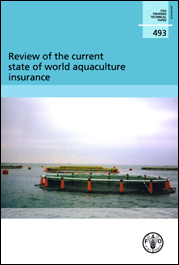van Anrooy, R.; Secretan, P.A.D.; Lou, Y.; Roberts, R.; Upare, M.
Review of the current state of world aquaculture insurance.
FAO Fisheries Technical Paper. No. 493. Rome, FAO. 2006. 92p.
Abstract
Due to the rapidly changing production processes in aquaculture worldwide (e.g.
submergible cages, sea ranching, intensification, aquaponics and recirculation
systems), which sometimes increase vulnerability to disease outbreaks and which
generally require large investments from aquaculturists, over the last decades
the demand for insurance to share and cover the risks involved has increased
significantly within the aquaculture sector. Risk management is increasingly
gaining attention within the aquaculture sector, which is reflected in the development
and increasing implementation of Better Management Practices (BMPs), Codes of
Conduct and Codes of Good Practice, Standard Operational Procedures, certification
and traceability. Aquaculture insurance is one of the tools used in aquaculture
risk management, but there is considerable ignorance within the aquaculture
industry about its availability, the process of obtaining insurance cover, especially
on aquaculture stock mortality, and the constraints to insurers providing its
services.
With this review study FAO intends to increase awareness of aquaculture producers
worldwide, particularly those in developing countries, on the opportunities
that aquaculture insurance can offer their businesses. FAO also aims to inform
decision-makers at national government levels as well as in international agencies
about the role of aquaculture insurance in the sustainable development of the
aquaculture sector and provide aquaculture sector stakeholders with insights
into what is all-too-frequently considered a complicated type of activity.
A review study carried out in early 2005 covered the main aquacultureproducing
countries worldwide. Seven regional syntheses (China, Asia, Europe, North America,
South America, sub-Saharan Africa and Oceania) were prepared, discussing the
specificities of their situation with regard to aquaculture insurance. A summary
of the regional syntheses was made, together with conclusions and clear recommendations
at various levels to increase the contribution of aquaculture insurance to the
sustainable management and development of the aquaculture sector.
Some of the main conclusions of the review study are the following: the demand
for aquaculture insurance has never been as high as it is now; there is a widening
gap between the demand for and supply of aquaculture insurance in the world;
the number of aquaculture insurance policies in force is estimated at around
8 000 worldwide; some regions (sub-Saharan Africa, South America and large parts
of Asia) are barely covered by aquaculture insurance services; aquaculture insurance
policies in force in Asia are generally of the "named perils" type, while those
in other regions are often of the "all risks" type; while the range of species
and culture systems covered under aquaculture policies worldwide is diverse,
many insurers only focus on a small number of traditional aquaculture species
and are reluctant to include "new" species and culture systems; reinsurance
is an important component of aquaculture insurance in a country and for developing
and disseminating the service; the underwriting experiences of aquaculture insurance
companies largely differ among companies and regions and from year to year;
since the start of the new millennium it seems that experiences are improving
and that aquaculture insurance activity is becoming profitable; mutual insurance
schemes in aquaculture are still insignificant; the lack of enabling policies
and regulatory frameworks for aquaculture and fisheries insurance is negatively
affecting the development of insurance services and the sustainable development
of the aquaculture sector; and asymmetric information, moral hazard and adverse
selection remain among the major constraints to undertake aquaculture insurance
activities for international and national insurance companies, which negatively
influence the results of new entrants in the aquaculture insurance sector during
the first few years of business.
|
